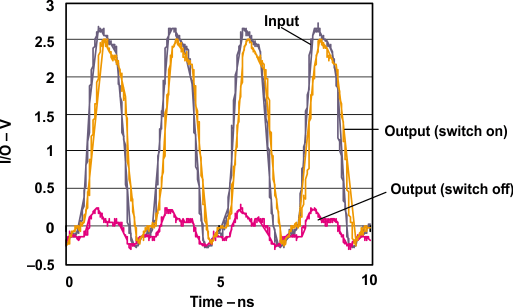SCDA008C June 2021 – November 2021 CD4052B , TS3A225E , TS3A44159
- Trademarks
- 1Introduction
- 2Semiconductor Switches
- 3Basic Signal-Switch Structures
- 4Key Concerns in Digital-Switch Applications
- 5Signal Switch Families
- 6Applications
- 7Conclusion
- 8References
- 9Revision History
-
A Test
Measurement Circuits
- A.1 Measurement Setup for ron
- A.2 Measurement Setup for VO vs VI Characteristics
- A.3 Voltage-Time Waveform Measurement (Switch On)
- A.4 Voltage-Time Waveform Measurement (Switch Off)
- A.5 Output-Skew Measurement
- A.6 Simulation Setup for Undershoot Measurement
- A.7 Laboratory Setup for Attenuation Measurement
- A.8 Laboratory Setup for Off Isolation Measurement
- A.9 Laboratory Setup for Crosstalk Measurement
5.3.1.3 Operation at High Frequency
Low input and output capacitance, low ron, and low feed-through capacitance makes the CB3Q devices suitable for high-speed applications. Maximum frequency of operation depends on input voltage range, type of load, edge rate, type of package, off-isolation, crosstalk requirement, and so forth At high frequencies, off-isolation and crosstalk also increase, which limits the maximum frequency of operation. Figure 5-14 shows the input and output voltage waveforms at a frequency of 420 MHz, with a 500-Ω and 3-pF load. From Figure 5-14, it is clear that the switch, when on, allows high-frequency signals to pass without distortion. Also, the switch provides very good isolation between the input and output when it is turned off or disabled.
 Figure 5-14 Input and Output Voltage Waveforms for the CB3Q3306A at 420 MHz (VCC = 3.3 V)
Figure 5-14 Input and Output Voltage Waveforms for the CB3Q3306A at 420 MHz (VCC = 3.3 V)